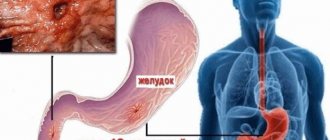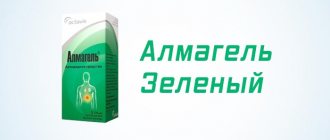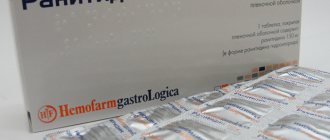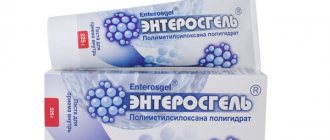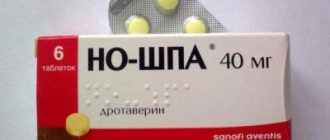When should you take antacids?
Antacids are prescribed to get rid of heartburn, which is a companion to many diseases of the digestive tract, including: stomach ulcers, reflux esophagitis, functional dyspepsia, etc.
In past years, antacids were widely used to treat various pathologies of the digestive system. However, the discovery of proton pump inhibitors and H2 receptor blockers, these drugs faded into the background. Modern drugs not only temporarily neutralize increased stomach acidity, but also reduce acid production, and they act for quite a long time.
However, antacids were not forgotten. Their advantage is the high speed with which they begin to act. In addition, antacids have a lower cost compared to proton pump drugs and H2 blockers.
Natural antacids
For heartburn and dyspepsia, it is important to adjust your diet using natural products to relieve acidity.
Be sure to read:
Intestinal ulcer: symptoms and manifestations of the disease, treatment methods The best products in this sense are milk and meat. Their absorption requires a large amount of hydrochloric acid and pepsin, and the duration of their presence in the stomach is several hours. To normalize acidity, it is useful to eat boiled or baked fish. Wheat bran works very well; its structure resembles a sorbent.
Oatmeal works the same way, especially with the addition of raisins and fresh pineapple. Any boiled porridge is useful, especially with milk.
During the season, it is advisable to eat as many watermelons and melons as possible, which perfectly reduce acidity. At any time of the year, you need to eat as many starchy vegetables as possible - potatoes, bell peppers, cabbage, carrots, zucchini, legumes, which are best boiled.
People who have been ill for a long time successfully use natural drug substitutes:
- fresh potato juice;
- cabbage juice (if fresh is not tolerated, you can boil the cabbage with a pinch of caraway seeds, eat it pickled or use it to make a vinaigrette);
- grapes and raisins - these products have an alkaline reaction;
- figs – fresh or dried;
- herbal tea made from mint, anise and lavender;
- a piece of white bread sprinkled with cinnamon;
- chicory decoction;
- fresh bananas - soothe not only heartburn, but also pain;
- cloves - in the form of seasoning or a few drops of oil diluted with water;
- natural honey (dissolve in water and drink);
- aloe leaf juice (1 teaspoon of juice in half a glass of water);
- ginger – chew a piece of fresh ginger or brew it as tea.
However, you need to understand that products do not act like drugs, but slowly and gradually. To relieve heartburn, you need to eat regularly, prepare food properly (boil, bake or use a steamer), avoid stress and long breaks in nutrition.
In continuation of the topic, be sure to read:
- Heartburn medications: review of tablets and features of their use
- What medications should I use for increased gas formation?
- What laxative is suitable for older people?
- List of choleretic drugs for bile stagnation
- Details about the coprogram: preparation, conduct and interpretation of the analysis
- Rectal fissure: causes, symptoms and treatment of pathology
- Irritable bowel syndrome: symptoms and treatments
- Causes of bloating and increased gas formation, treatment methods
- Antihistamines: list of medications and features of their use
- Carminative drugs for adults and children: list of medicines
How antacids work
The stomach needs acid so that it can digest food. It is a very caustic substance, but it does not corrode the gastric walls, since they are covered with a special mucous layer. It is this that protects the stomach from the destructive effects of acid and prevents erosions and ulcers from forming.
However, sometimes the mucous membrane is damaged due to various circumstances, which gives acid access to the walls of the stomach, and it begins to corrode them. As a result, a person develops an ulcer. When the sphincter, which is a natural partition between the stomach and esophagus, weakens, acid can be thrown up. As a result, it begins to irritate the walls of the esophagus, causing inflammation of the organ. This phenomenon is called “reflux esophagitis.”
Taking antacids allows you to neutralize the acid in the stomach, since these drugs contain alkaline bases. They work to counteract acids. This reaction is called a neutralization reaction in scientific circles.
After taking antacids, the aggressiveness of gastric juice decreases, which reduces the pain that can cause ulcerative lesions. Also, these drugs quickly relieve heartburn.
Mechanism of action
The mechanism of action of all antacids is approximately the same - they interact in the stomach cavity with hydrochloric acid, converting it into neutral salts . Acidity decreases (to 4.0-5.0 pH). At the same time the activity of gastric juice enzymes (pepsin) decreases and the tone of the lower esophageal sphincter increases.
To determine the potency of an individual antacid, the term “acid neutralizing activity” was proposed. This is the amount of hydrochloric acid that can be neutralized by a standard dose of the drug in 24 hours. All modern antacids that can be found in pharmacies have medium or high acid-neutralizing activity.
Numerous studies have shown that the effect of antacid drugs is not limited to the neutralization of hydrochloric acid and a sharp decrease in acidity in the stomach. They also have other pharmacological effects:
- Enveloping the walls of the stomach , which helps reduce the negative effect of aggressive factors on the mucous membrane.
- Absorption of bile acids that enter the stomach during duodenogastric reflux. They contain lysolecithin, a substance that increases the permeability of cell walls and destroys the epithelium of the mucous membrane. It is believed that it may be an independent factor in the development of stomach cancer.
- Stimulation of the synthesis of biologically active substances that increase the production of bicarbonates and mucus by the gastric glands.
- Acceleration of the healing process of erosions or ulcers of the mucous membrane.
- Decreased tone of smooth muscle fibers (relieving spasm) of the stomach wall . This reduces the patient's pain.
- Partial adsorption and neutralization of foods or drinks that have a negative effect on the mucous membrane.
- Reduced rate of evacuation of stomach contents into the duodenum.
- Reducing gas formation in the stomach , which helps reduce internal pressure on the wall.
Recent studies have shown that the healing rate of duodenal ulcers after 4 weeks of treatment with antacids averaged 73%, which significantly exceeded the effectiveness of placebo.
Thus, antacids with a gastroprotective effect can not only reduce symptoms, but also be used as complete monotherapy for ulcers or gastritis in mild cases of the disease.
Types of antacids
Calcium, magnesium and aluminum compounds are the basis of antacids. Depending on how the body absorbs the drug, antacids are distinguished between absorbable and non-absorbable.
Absorbed drugs are absorbed by the intestinal walls and dissolve in the blood. This determines the rapid therapeutic effect of taking the drug. However, they also have a negative side - a large number of side effects. Therefore, experts do not recommend taking them. Absorbable antacids include baking soda and calcium and magnesium carbonate medications.
Non-absorbable antacids do not have a lightning-fast effect, but they last much longer. The main active ingredient is aluminum and magnesium hydroxide or aluminum phosphate. Sometimes they are combined in one drug. Aluminum envelops the gastric wall, covering it with a protective barrier, and magnesium restores the damaged mucous barrier. Drugs that belong to the group of non-absorbable antacids: Almagel, Phosphalugel, Maalox, Gastal, etc.
Sometimes doctors prescribe combination medications that have not only antacid, but also other therapeutic effects. Such drugs are used to relieve symptoms and to eliminate one or another pathology of the gastrointestinal tract (in complex therapy), and they can also reduce the severity of side effects from taking antacids.
For example, a drug called Almagel Neo contains simethicone, which helps eliminate flatulence. Bloating is often observed after taking antacids. However, simethicone allows you to break up gas bubbles in the intestines and remove them out.
Also in the composition of antacids you can find alginic acid and its salts, alginates. This helps protect the walls of the esophagus from stomach acid. Once in the stomach, sodium alginate or alginic acid is converted into a gel. It floats on the surface of the gastric contents and prevents them from leaving the organ. As a result, the esophagus remains protected from irritation. Such drugs are often used in the complex treatment of reflux esophagitis. For example, this is a drug called Gaviscon.
You can also find antacids with an analgesic component, for example, a drug called Almagel A.
Features of the use of antacid drugs for various pathologies
The choice of antacid is made by the doctor, based on the characteristics of the specific clinical picture. The use of this group of drugs has its own nuances for each disease.
Peptic ulcer
Non-absorbable antacids are used before starting the use of proton pump inhibitors and on the first day after their prescription, and the size of the ulcers should not exceed 1 cm. It is possible to use these drugs after removing Helicobacter for the symptomatic treatment of heartburn, neutralizing the “acid rebound” of certain drugs, as well as for relapse prevention. Almagel and its varieties have gained the greatest popularity for peptic ulcers.
Chronic and acute duodenitis, gastroduodenitis
Non-absorbable antacids are used, but only as a complement to histamine blockers and proton pump inhibitors.
Medicines help to quickly suppress inflammation and prevent another exacerbation. When using NSAIDs, antacids are used as a protective agent. The most widely used drug in this situation is Talcid in the form of chewable tablets. The active substance is hydrotalcite, which has a crystalline layered network structure, from which aluminum and magnesium ions are released in the stomach. Permanently and firmly binds hydrochloric acid, bile acids, stimulates the protective factors of the stomach. Be sure to read:
Stool analysis for Helicobacter pylori: how to take it correctly?
After a single dose of the tablet, a sufficient concentration of antacid ions lasts up to 90 minutes. You can chew the tablets as needed, but no more than 12 per day.
Due to the sorbing effect, Talcid should be taken 1-2 hours before or after meals or taking other medications. It is advisable to continue taking the tablets for 4 weeks after all symptoms disappear.
Periodic stomach pain, heartburn during pregnancy
In cases where heartburn and other dyspeptic symptoms occur rarely and are caused by overeating, excessive consumption of coffee and other irritants, it is recommended to take absorbable antacids.
The best drugs for this are Rennie, Bourget's mixture, Tams, Andrews antacid. Medicines are used in an “on demand” mode, their effect develops within 3-5 minutes, with occasional use there are no side effects or complications.
Gastroesophageal reflux disease (GERD)
This is a constant reflux of gastric contents into the esophagus, which damages its lower part.
This condition can also occur in a healthy person due to physical overexertion, stress, or infections. However, if this happens continuously, treatment is required.
Treatment for GERD is complex, but antacids must be taken regularly. International guidelines suggest using non-absorbable antacids in the following sequence: Phosphalugel → Maalox (Almagel) → Gaviscon (Topalcan).
In this case, the most effective are considered to be second generation or aluminum-magnesium antacids: Maalox, Megalac, Almagel. The variety of trade names is due to marketing requirements, but their active ingredients are the same.
List of absorbable antacids
Absorbable antacids are substances that dissolve in the blood. The acidity of gastric juice decreases very quickly after taking them. However, such drugs do not last long. In addition, they cause the so-called acid rebound, in which the production of hydrochloric acid increases immediately after the drug ceases to act. The disadvantages of absorbed antacids also include the fact that they contribute to increased formation of carbon dioxide in the body, which leads to overstretching of the gastric walls and provokes gastroesophageal reflux. The entry of bicarbonates into the bloodstream leads to systemic alkalosis.
The longer a person takes antacids, the more likely they are to develop constipation and hypercalcemia. If these drugs are combined with milk, vomiting, polyuria, and transient azotemia may develop. The development of urolithiasis also cannot be ruled out.
Drugs from the group of absorbable antacids:
- Sodium bicarbonate.
- Calcium carbonate.
- Basic magnesium carbonate.
- Magnesium oxide.
- A mixture of Bourget based on phosphate and sodium sulfate with the addition of bicarbonate.
- Medicines: Rennie, Andrews antacid, Tams.
Conclusion
Antacids are drugs that have proven their effectiveness. Modern complex formulations make it possible to minimize side effects and prolong the therapeutic effect. Outdated formulations should be abandoned.
In general, antacid medications are well tolerated and provide rapid results. However, taking them for a long time, without a doctor’s prescription, is undesirable.
The short-term effect of absolutely all antacids (up to 4 hours) inevitably leads to the fact that to maintain the level of optimal acidity, they need to be taken frequently. This is inconvenient and inevitably carries the risk of side effects. Therefore, they are most often used in emergency cases or in complex therapy of chronic gastritis and stomach ulcers.
List of non-absorbable antacids
Non-absorbable antacids are based on aluminum hydroxide, aluminum phosphate, magnesium hydroxide and magnesium trisilicate. Their effect is somewhat delayed in time, but it lasts for 3 hours. They reduce the acidity of gastric juice, leaving it at around 3-4 pH.
The following groups of non-absorbable antacids are distinguished:
- Based on aluminum phosphate: Alfogel, Gasterin, Phosphalugel.
- Based on aluminum and magnesium: Almagel, Altacid, Alumag, Gastracid, Maalox, Maalukol, Palmagel.
- Topalcan and Gaviscon are based on a combination of sodium and calcium or silicon, aluminum and magnesium with the addition of alginate.
- The preparations Almagel A and Palmagel A contain a combination of aluminum and magnesium with the addition of benzocaine, which has an analgesic effect.
- The drugs Almagel Neo, Gestid and Relzer are based on magnesium and aluminum, but they also contain simethicone, which reduces gas formation in the intestines.
- Preparations containing aluminum, calcium and magnesium: Renny-Tal, Rutacid, Taltsid, Tisacid. Magnesium hydroxide and hydrotalcite are present in the drug Gastal.
Classification
The classification is based on absorption ability. Antacids are divided into two categories - absorbable and non-absorbable. The first group is considered outdated and has a large number of side effects. The second group is more modern and in some cases can be prescribed even during pregnancy.
Please note that this division is conditional. Since even non-absorbable antacids can partially enter the blood plasma. Although significantly smaller than the first group.
Comparison of the effects of taking different antacids
A study of the antacid properties of various drugs was carried out at the Central Research Institute of Gastroenterology. For this purpose, the method of intragastric pH-metry was used. The obtained data are presented in the table.
| Criteria | Name of the drug | ||||
| Almagel | Remagel | Phosphalugel | Megalax | Maalox | |
| Onset of effect in minutes | 13,5 | — | — | — | 8,9 |
| Duration of action in minutes | 28 | 32,5 | 40 | 46 | 56 |
| Alkalinization area | 6,6 | 4,5 | 5,4 | 6,5 | 13,2 |
| Alkalinity index | 9,0 | 11,4 | 6,7 | 13,5 | 18,0 |
Maalox began to act faster than other drugs, and Almagel began to act later than all others. Maalox also turned out to be the leader in the duration of the effect. The effect of Almagel ended the fastest: 56 minutes versus 28 minutes. Steel preparations are “between” the leader and the laggard. Analysis of all the data obtained allows us to conclude that the drug Maalox has the maximum degree of alkalizing effect.
Antacids
Antacids
(from Greek ἀντἰ- - against, Latin
acidus
- sour) - medications whose mechanism of action is based on the chemical neutralization of gastric acid.
Composition of antacids
The main acid-neutralizing active ingredients of modern antacids are magnesium, aluminum and calcium compounds.
Many of the modern antacid drugs, in addition, contain components that affect the gastrointestinal tract in a way other than neutralizing the acid: laxatives, carminatives, antispasmodics, anesthetics and others. Most modern antacid preparations use a balanced combination of magnesium compounds (magnesium oxide, magnesium hydroxide, magnesium peroxide, magnesium carbonate) and aluminum (aluminum hydroxide, aluminum phosphate and others). Such antacid drugs are characterized by a slower onset of therapeutic effect compared to sodium and calcium compounds, but they have a longer effect time. Such compounds do not dissolve in water, are practically not absorbed into the blood, are characterized by antipeptic properties and partially adsorb toxins. Aluminum compounds help slow intestinal motility and in large quantities can cause constipation, while magnesium compounds accelerate intestinal motility and have a laxative effect. Aluminum compounds enhance the synthesis of prostaglandins, promote the formation of a protective film on the surface of damaged tissues, adsorb bile acids and lysolecithin, and increase the tone of the lower esophageal sphincter. Magnesium compounds increase mucus formation and resistance of the gastric mucosa. The table below (Kharchenko N.V., Chernenko V.V.) shows the effects of the main components of modern antacid drugs (- no effect, + low activity, ++ medium activity, +++ high activity).
| Characteristics of some components of modern antacids | ||||
| Action/cations | Mg | Ca | Al | Bi |
| Neutralizing | +++ | + | ++/+++ | – |
| Adsorbent | + | + | +++ | + |
| Enveloping | – | – | + | – |
| Astringent | – | – | + | +++ |
| Cytoprotective | – | – | +++ | + |
Absorbable antacids
Absorbed antacids are those that either themselves or the products of their reaction with gastric acid dissolve in the blood. A positive quality of absorbed antacids is the rapid decrease in acidity after taking the medicine. Negative - short duration of action, acid rebound (increased secretion of hydrochloric acid after the end of the drug), the formation of carbon dioxide during their reaction with hydrochloric acid, stretching the stomach and stimulating gastroesophageal reflux (see figure from the article by D.S. Bordin, below and on the right)
. Absorption of bicarbonates into the blood can lead to the development of systemic alkalosis. Long-term use of calcium-containing absorbable antacids can cause constipation and hypercalcemia, and in combination with milk or dairy products - milk-alkali syndrome, manifested by nausea, vomiting, polyuria, transient azotemia. The development of calcium kidney stones and nephrocalcinosis is possible.
Examples of absorbable antacids:
- sodium bicarbonate (baking soda)
- calcium carbonate
- magnesium carbonate basic
- magnesium oxide
- Bourget mixture (a mixture of sodium bicarbonate, sulfate and sodium phosphate)
- medicines "Rennie", "Tums", "Andrews Antacid" (a mixture of calcium carbonate and magnesium carbonate).
Non-absorbable antacids
The active components of non-absorbable antacids are aluminum hydroxide, aluminum phosphate, magnesium hydroxide, magnesium trisilicate.
Non-absorbable antacids begin to act later than absorbable ones, but their duration of action is longer and reaches 2.5–3 hours. They are buffered against hydrochloric acid of gastric juice and, due to this, maintain acidity during their period of action within the range of 3–4 pH. Non-absorbable antacids are divided into the following groups:
- with aluminum salt of phosphoric acid - aluminum phosphate (preparations based on them: Alfogel, Gasterin, Phosphalugel)
- aluminum-magnesium combinations, the most common of which is “algeldrate + magnesium hydroxide” (antacid preparations: “Almagel”, “Altacid”, “Alumag”, “Gastratsid”, “Maalox”, “Maalukol” and “Palmagel”)
- aluminum-magnesium-silicon or sodium-calcium combinations with the addition of alginate (antacid drugs: Topalcan, Gaviscon)
- aluminum-magnesium combinations with the addition of the anesthetic benzocaine (antacid preparations: Almagel A, Palmagel A)
- aluminum-magnesium preparations with the addition of simethicone, used to prevent flatulence (antacid preparations: Almagel Neo, Antareit, Gestid, Relzer)
- combinations of aluminum, magnesium and calcium compounds: hydrotalcite (antacid preparations: “Renni-Tal”, “Rutacid”, “Taltsid”, “Tisacid”), hydrotalcite and magnesium hydroxide (“Gastal”) and others
Comparison of the effects of various antacids
At the Central Research Institute of Gastroenterology, using intragastric pH-metry,
studies were carried out on the acid-neutralizing effect of various antacids. Table 2 (see below) presents average data for some drugs: the time of onset of action of the antacid from the moment of taking the drug, the time of action of the antacid drug, the area of alkalization (corresponding to the volume of acid neutralized by the antacid) and the alkalization index, equal to the area of alkalization divided by the acidity of the stomach juice at the time the drug begins to act.
| Indicators | A drug | ||||
| Almagel | Remagel | Phosphalugel | Megalac | Maalox | |
| Action onset time, min | 13,5 | – | – | – | 8,9 |
| Action time, min | 28 | 32,5 | 40 | 46 | 56 |
| Alkalinization area | 6,6 | 4,5 | 5,4 | 6,5 | 13,2 |
| Alkalinity index | 9,0 | 11,4 | 6,7 | 13,5 | 18,0 |
The time for the onset of antacid action after administration was the shortest for Maalox (an average of 8.9 minutes), the longest for Almagel (an average of 13.5 minutes). The average duration of the alkalizing effect of antacids also varied widely, from 28 minutes for Almagel to 56 minutes for Maalox. At the same time, Remagel, Phosphalugel and Megalac occupied an intermediate position between them. Analysis of pH grams showed that the maximum acidity values after taking various antacids differed slightly. However, the indicators of the severity of the alkalizing effect—the time to reach maximum pH values and the duration of “retention” of the maximum effect—were most optimal for Maalox (Ilchenko A.A., Selezneva E.Ya.).
Dosage forms of antacids
The most common forms of release of antacid drugs are: tablets, lozenges, oral suspension in a bottle, oral suspension in sachets containing a single dose of the drug.
The release form is important for the neutralizing ability of the antacid, as well as for its convenience for use by patients. Antacids interact with hydrogen ions only in a dissolved state, so solubility is an important parameter affecting the effectiveness of antacids. Suspensions are made up of smaller particles than tablets, so they have a larger surface area and dissolve faster in the stomach. Pre-chewed and dissolved tablets are more effective than tablets swallowed whole. However, taking the suspension is not always convenient for patients who lead an active lifestyle, so some of them take the suspension at home and tablets in public places.
The use of antacids for heartburn and the treatment of gastroesophageal reflux disease
Antacids can be used both as monotherapy for rare heartburn, which is not accompanied by the development of esophagitis, and in complex treatment regimens for gastroesophageal reflux disease (GERD), as they are effective in quickly eliminating symptoms.
Aluminum phosphate 2.08 g, combination preparations - magaldrate 400 or 800 mg and simethicone 20 or 40 mg, aluminum hydroxide 400 mg and magnesium hydroxide 400 mg are used in the treatment of moderate and infrequently occurring symptoms, especially those associated with non-compliance with the recommended lifestyle life. A combined drug containing magaldrate and simethicone is able to quickly neutralize hydrochloric acid and maintain a stable pH level for a long time, and very actively bind bile salts. With its use, symptoms disappear in most patients with GERD.
Antacids should be taken depending on the severity of symptoms, usually after meals and at night until the symptoms of the disease are persistently relieved, then “as required.” There is insufficient data indicating the possibility of their constant use (Recommendations of the Russian State Administration for the diagnosis and treatment of GERD, 2020).
Antacids in the treatment of duodenal ulcers
Modern medical science absolutely rightly believes that the main drugs used in the treatment of acid-dependent diseases should be drugs that most effectively inhibit gastric acid production, which today are proton pump inhibitors. Taking any antacids and adsorbents during Helicobacter pylori
is undesirable due to a possible decrease in the effectiveness of antibacterial treatment. Antacids, having given way to proton pump inhibitors and other antisecretory drugs in suppressing gastric acidity, occupy a significant niche in the treatment of acid-dependent conditions.
For example, a modern non-absorbable antacid based on the aluminum-magnesium combination “aluminum hydroxide + magnesium hydroxide” (for example, “Almagel”, “Altacid”, “Alumag”, “Gastratsid”, “Maalox”, “Maalukol”, “Palmagel” and similar) can be used in the treatment of duodenal ulcers in the following situations (Maev I.V., Samsonov A.A., Minushkin O.N.):
- for pain relief during the screening phase, as well as on the first day of taking proton pump inhibitors before the start of blockade of acid production
- with small ulcer sizes (no more than 1.0 cm) and a short history of ulcers, in the absence of Helicobacter pylori
, aluminum-magnesium antacids can be prescribed as the only drug. - for ulcers larger than 1.0 cm, for long-term non-healing ulcers, such antacids are used in combination with proton pump inhibitors in order to enhance the cytoprotective effect (growth factor fixation phenomenon) - for ulcers not associated with Helicobacter pylori
, as well as for associated ones, in cases with difficult to scar ulcers - in the case of the use of histamine H2-blockers and their withdrawal, to level out a possible “acid rebound”
- after eradication of Helicobacter pylori
to relieve possible episodic pain and heartburn - as anti-relapse therapy
The use of antacids in the treatment of chronic duodenitis
Antacids in the treatment of chronic duodenitis are used in the following situations (Maev I.V., Samsonov A.A.):
- as an additional antisecretory agent to H2 blockers or proton pump inhibitors, as an additional adsorbent agent in the treatment of acute gastroduodenitis or acute duodenitis
- as an additional antisecretory agent during therapy with H2 blockers or proton pump inhibitors during exacerbation of chronic gastroduodenitis or chronic duodenitis, including against the background of celiac disease, gastric and duodenal ulcers, liver or pancreas diseases
- at the end of eradication of Helicobacter pylori
in peptic ulcer with symptoms of secondary duodenitis, to reduce pain and dyspeptic symptoms (pain or discomfort, heaviness, fullness, early saturation, localized in the epigastric region) in the period until the final scarring of the ulcerative defect and the subsidence of the phenomena of secondary inflammation - in order to prevent relapses of chronic duodenitis
- to prevent the occurrence of gastro- and duodenopathy while taking NSAIDs, either alone or in combination with antisecretory drugs;
- to level out a possible “acid rebound” after completion of H2-blocker therapy
Publications for healthcare professionals regarding antacids
- Ivashkin V.T., Maev I.V., Trukhmanov A.S., Lapina T.L., Storonova O.A., Zayratiants O.V., Dronova O.B., Kucheryavyi Yu.A., Pirogov S. S.S., Sayfutdinov R.G., Uspensky Yu.P., Sheptulin A.A., Andreev D.N., Rumyantseva D.E. Recommendations of the Russian Gastroenterological Association for the diagnosis and treatment of gastroesophageal reflux disease. Russian Journal of Gastroenterology, Hepatology, Coloproctology. 2020;30(4):70–97.
- Maev I.V., Vyuchnova E.S., Dicheva D.T. and others. Gastroesophageal reflux disease (educational manual). - M.: VUNTSMZ RF, - 2000.
- Belmer S.V., Gasilina T.V., Kovalenko A.A. Methods for assessing the individual effectiveness of antacid and antisecretory drugs in pediatric gastroenterology (work experience). - M.: RGMU. – 2001. – 32 p.
- Ilchenko A.A., Selezneva E.Ya. Computer pH-metry of the stomach and esophagus. Clinical significance of the method: Methodological recommendations No. 15.-M.: Department of Health of the Moscow Government. – 2001. – 40 p.
- Ivashkin V.T., Baranskaya E.K., Shifrin O.S. and others. The place of antacids in modern therapy of peptic ulcer // Russian Medical Journal. Diseases of the digestive system. – 2002. – T.4. – No. 2.
- Ermolova T.V., Shabrov A.V., Kasherininova I.I., Ermolova S.Yu. The role of modern antacids in gastroenterological practice // Practical Medicine. – 2003. – No. 4. – p. 46–47.
- Vasiliev Yu.V. Enveloping (antacid) drugs in the treatment of certain diseases of the upper digestive tract. Russian Medical Journal. - 2004. - Volume 12. - No. 5.
- Maev I.V., Samsonov A.A. The use of modern antacids in the treatment of acid-dependent diseases of the gastrointestinal tract // Handbook of a polyclinic doctor. – 2005. – No. 5.
- Ushkalova E.A. Clinical pharmacology of modern antacids // Farmateka. – 2006. – No. 11. – p.1–6.
- Bordin D.S. Advantages of non-absorbable antacids // Attending Physician. – 2010. – No. 8.
- Minushkin O.N., Elizavetina G.A. Antacids in modern therapy of acid-dependent diseases // Gastroenterology of St. Petersburg. - 2010. - No. 2-3. - With. 9-12.
- Kolesnikova I.Yu., Volkov V.S. Diagnosis and treatment of acid-related diseases of the digestive tract. Guide for doctors / M.: Publishing House “Medical Information Agency”, 2014. - 432 p.
On the website in the literature catalog there is a section “Antacids”, containing articles devoted to the treatment of diseases of the gastrointestinal tract with antacids.
Group of antacids in classifiers
In the International Anatomical Therapeutic Chemical Classification, the subsection Drugs for the treatment of diseases associated with acidity disorders includes the group “Antacids, code A02A”, which has eight subgroups:
- A02AA Magnesium preparations
- A02AB Aluminum preparations
- A02AC Calcium preparations
- A02AD Combination of aluminum, calcium and magnesium preparations
- A02AF Antacids in combination with carminatives
- A02AG Antacids in combination with antispasmodics
- A02AH Antacids in combination with sodium bicarbonate
- A02AX Antacids in combination with other drugs
In the Pharmacological Index, in the section Gastrointestinal Drugs, there is a group “Antacids and Adsorbents”. Back to section
How to take antacids?
Before taking antacids, it is recommended to consult a doctor and also study the instructions that come with each medicine. Most often, antacids are aimed at eliminating the symptoms of a particular digestive disease, or in order to prevent their occurrence.
How long does it take for the effect to occur? How long should antacid treatment last?
Absorbed drugs begin to act very quickly, almost immediately after administration. Non-absorbable antacids have the desired effect after 10-15 minutes.
As for the duration of use, it is determined by the frequency of heartburn. When this symptom does not bother you, there is no point in treatment.
However, sometimes doctors prescribe a course of antacids, but for this purpose they use only those drugs that contain medicinal components. They are also used in combination with proton pump inhibitors.
When are they appointed?
Antacids are actively used for the following pathologies of the digestive tract:
- peptic ulcer of the stomach or duodenum;
- gastritis;
- duodenitis;
- reflux esophagitis;
- esophagitis;
- duodenogastric reflux;
- dyspeptic disorders after excessive intake of spicy, sour foods, alcoholic or carbonated drinks;
- intestinal infections with active nausea and vomiting;
- hiatal hernia.
Drugs of this drug group are most often used in addition to antisecretory drugs (proton pump inhibitors, histamine receptor blockers).
Please note: A number of researchers recommend using antacids also when taking anti-inflammatory drugs (NSAIDs or glucocorticosteroids). Their long-term use inhibits the production of prostaglandins, a key factor in the protection of the gastric mucosa, which often leads to the development of gastritis, erosions or ulcers.
Antacids are actively prescribed if the patient has congenital resistance or intolerance to proton pump inhibitors.
Side effects
Side effects from taking antacids may include the following: diarrhea, belching, constipation. They largely depend on the drug the person is taking.
Absorbed antacids lead to the so-called acid rebound. The body, in which acidity is sharply reduced, resists this and increases it even more. In addition, taking absorbable antacids increases the production of carbon dioxide, which stretches the walls of the stomach and causes gastroesophageal reflux. If the drug contains calcium, this can cause constipation, nausea and vomiting. Frequent use of such medications leads to the formation of kidney stones.
Antacids with magnesium in their composition help to thin the stool and, if taken for a long time, can cause diarrhea, as well as problems with the kidneys.
When aluminum is present in antacids, there is a risk of constipation. In addition, there is a risk of brain inflammation, and bone tissue may lose its strength.
It is not recommended to take antacids with other medications, as they can reduce their absorption.
Effects
Pharmacology has come up with many combinations of medications that have an antacid effect. In addition to the main one - neutralization of an acidic environment, they successfully perform the following functions:
- Sorb harmful substances.
- Relieves heaviness and pain.
- Capable of binding bile acids.
- Prevents flatulence.
- They have a cytoprotective effect on the cells of the stomach walls.
- They envelop the stomach, reliably protecting it from ulcerogenic effects.
How can antacids harm your health?
In addition to the side effects themselves, antacids may react poorly with other prescription or over-the-counter medications.
Mixing medications can cause a variety of side effects, ranging from minor side effects such as nausea to serious conditions that can cause organ failure or, in rare cases, death. People who take medications for asthma, diabetes, heart problems, depression, gout, arthritis, or seizures should never take antacids without first consulting a doctor. Certain people should never take antacids. For people with drug allergies, it is important to read the list of active ingredients on all antacid labels to avoid ingesting anything that could cause an allergic reaction. Additionally, people on a low-sodium diet should avoid antacids that contain sodium bicarbonate or aluminum hydroxide and magnesium carbonate due to their high sodium content. People who suffer from kidney problems should also avoid these foods without their doctor's approval.
Antacids for children
Children have diseases that require the use of antacids. These are gastroduodenitis, erosion or ulcer of the gastrointestinal mucosa, heartburn due to an unbalanced diet. If you need to choose a medicine for a young child (up to 10 years), it is worth considering that absorbable antacids are strictly prohibited. The reason is the rebound effect, penetration into the circulatory system, and possible side effects.
You can choose a medicine for your child from non-absorbable antacids: these are Maalox, Gaviscon, Alumag, Almagel, Phosphalugel and others. Phosphalugel does not disturb the phosphate balance and washes calcium from the bones. Allowed for children, with a dosage reduced by 2–4 times (compared to adults). The doctor gives precise recommendations on the drug. Long-term use of even approved antacids is not recommended for children: it is necessary to treat the disease, and not alleviate its symptoms.
Drug interactions
Like any other medications, antacids can cause undesirable effects when interacting with other drugs. Due to the fact that the drugs envelop the wall of the stomach and intestines, they reduce absorption and can cause a decrease in the therapeutic effect:
- antibiotics from the group of tetracyclines, fluoroquinolones;
- proton pump inhibitors;
- cardiac glycosides;
- anti-tuberculosis drugs;
- beta blockers;
- some antifungal agents.
Doctors recommend increasing the interval between taking antacids and one of these drugs. It is advisable that it be 2-3 hours.
Despite the fact that modern standards of treatment for diseases of the stomach and duodenum with high acidity imply the prescription of a whole range of drugs (H2-histamine receptor blockers to reduce the production of hydrochloric acid, antibiotics to eliminate Helicobacter and others), antacids remain one of the popular remedies for eliminating heartburn. The duration of taking these drugs, as well as the required dosage, should be determined by the attending physician. The average course of treatment is 2-4 weeks.
How to choose the best Antacid?
The best antacid depends not only on which type helps combat symptoms such as heartburn and indigestion, but also on the speed of relief.
Ingredients are a critical factor when choosing the best antacid for you because they vary greatly between products. Not all ingredients in antacids are safe for people with certain medical conditions, so if you have any doubts, it's best to ask your doctor for his or her recommendation. Different minerals are used in different types of antacids, and they tend to have unique effects on the body, including the digestive system. If you are easily susceptible to diarrhea, you will likely find that antacids containing magnesium, such as milk of magnesia, may cause you more digestive distress. If your problem is constipation, the best antacid for you probably won't be a product that contains aluminum. Aluminum hydroxide, found in some antacids, can cause the side effect of constipation in some people, especially those who are already prone to constipation. It is always wise to read antacid ingredient labels before purchasing a product.
Release form
Antacids are available in the form of lozenges or suspensions. There are ready-to-use mixtures or powder for preparing medicine, packaged in sachets. The release form directly affects ease of use and neutralizing ability:
- Tablets are more convenient to take - they do not need to be washed down with water, you just need to chew them.
- Suspensions are more effective because their particles are smaller and the area of distribution is larger. Their thick gel structure better envelops the mucous membrane, providing pain relief and protection.
Absorbable antacids
This group of drugs (or the products of their chemical interaction) are absorbed by the intestines and enter the blood. They are characterized by fast but short action from 30 minutes to 2 hours. The chemical reaction they cause occurs with the release of carbon dioxide. This causes belching and flatulence, which after a while leads to heartburn again. They are characterized by “rebound syndrome” - 1–2 hours after administration, the production of hydrochloric acid increases, which aggravates the disease.
Article on the topic: Flemoclav Solutab tablets - instructions for use, price
Absorbable antacids contain calcium carbonate, magnesium carbonate, and sodium bicarbonate. These include: baking soda, Rennie, Vikalin, Vikair and others. They are carried throughout the body by the circulatory system - this increases the risk of side effects. The main ones: changes in the composition of the blood, disruptions in the cardiac system, effects on kidney function, edema, increased blood pressure, formation of kidney stones. Such signs appear more often when dairy products are taken simultaneously with medications. It is recommended to use them once, rather than in long courses.
Main contraindications for taking absorbable antacids:
- allergies or individual intolerance to components;
- severe renal failure;
- children under 12 years of age;
- hypercalcemia.
One of the widely used medications of this type is Rennie. These are chewable tablets with mint, cooling or orange flavors that neutralize excess hydrochloric acid and protect the mucous membrane of the digestive tract and stomach. The effect is felt after 5 minutes, thanks to excellent solubility and high calcium concentration:
- Active ingredients Rennie: calcium carbonate and magnesium carbonate.
- The release form of the medicine is tablets. Packaged in 6 or 12 pieces in blisters or heat-sealed aluminum packages. There are from 1 to 8 blisters in a pack.
- The cost of 24 tablets is in the range of 290–320 rubles.
- Taken at intervals of 2 hours or more, maximum daily dose is 11 tablets.
An affordable drug is Vikair tablets. They are prescribed to relieve the symptoms of peptic ulcers, gastritis with a tendency to constipation. Dosage – 1-2 pieces 3 times a day. Action of the medicine: antacid, astringent, laxative, antispasmodic. Ingredients: magnesium carbonate, sodium bicarbonate, bismuth subnistrate, calamus root, buckthorn bark. The price of a package of 10 tablets is 15–25 rubles.
How do antacids work?
The mechanism of action directly depends on which metal compounds are used as the active ones. The main effect of all drugs in this group is the neutralizing, eliminating effect of hydrochloric acid. Additional actions depend on the metal in the base of the active substance.
Magnesium compounds have a pronounced neutralizing effect, a partial adsorbing effect, and practically no enveloping or astringent effect.
Calcium compounds are somewhat weaker in terms of neutralization, but have similar adsorbing properties. They have virtually no cytoprotective, astringent or enveloping effects.
Aluminum compounds are considered the most effective. They have a pronounced neutralizing effect, cytoprotective, actively adsorb, and also have a mild enveloping and astringent effect.
Bismuth antacids are a subgroup of antacids that are more often used as adsorbents with cytoprotective and astringent effects.
Indications for use
Having defined what antacids are, we will find out for what purpose they are prescribed to patients. First of all, they are prescribed to neutralize excess hydrochloric acid in pancreatic juice - it is this that contributes to the development of heartburn and ulceration of the gastric mucosa.
Prescribed for diseases that are accompanied by excessive pressure in the intestines and stomach with a corresponding disturbance of peristalsis.
Effective for spasms and pain caused by them in the stomach, as well as for the release of the contents of the duodenum into the stomach. It is important to understand that such antacid medications play a key role in the treatment of gastroesophageal reflux disease and esophagitis , an inflammatory disorder of the esophagus.
These drugs are prescribed only in cases where gastrointestinal diseases are not complicated by peptic ulcers of the intestines and stomach.
Adverse reactions
Any drug on the list of antacids is tolerated quite well if prescribed correctly and not taken excessively. In rare cases, individual complications develop after their use.
Magnesium-containing medications can have a laxative effect and even cause diarrhea after you stop taking them. Medicines containing aluminum or calcium have the opposite effect, causing constipation and reducing intestinal motility even with proper nutrition.
It is extremely rare to develop intolerance, which manifests itself in the form of skin rashes, nausea, vomiting, and swelling. Large dosages of drugs can cause lethargy and drowsiness.
Main uses of Antacids
The main use of an antacid is to relieve heartburn, which causes a burning sensation in the chest. Heartburn occurs when stomach acid begins to build up in the esophagus. Heartburn victims will find relief, but heartburn may be an indicator of a more serious problem, such as an ulcer. Heart attacks have symptoms similar to heartburn, so you should discuss all symptoms carefully with your doctor. Many people think that antacids help with flatulence, but this is not true.
Useful video
We found out what antacid drugs are. Antacids, the list of which is given in the article, should be prescribed under the supervision of a physician. Useful information can also be found in this video.
For peptic ulcer
In the treatment of intestinal ulceration, drugs from the group of proton pump inhibitors are often used. The use of antacids in this case is undesirable, as it greatly reduces the effectiveness of antibacterial therapy.
Non-absorbable drugs, for example, Gastracid , Almagel and similar ones, are used if it is necessary to relieve pain if the ulcer is of small diameter. To relieve pain, gel antacids with anesthetics are chosen. Also used to prevent relapse and acid rebound.

